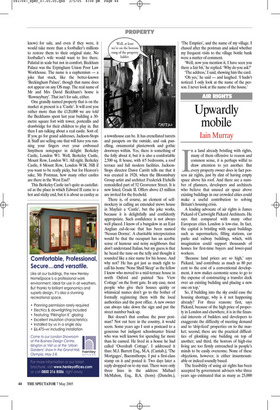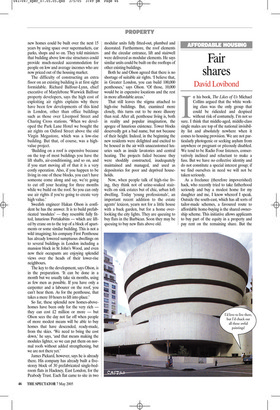Upwardly mobile
Iain Murray
In a land already bristling with rights, many of them offensive to reason and common sense, it is perhaps wilful to draw attention to yet another. But every property owner does in fact possess air rights, just by dint of having empty space above his roof. And there are a number of planners, developers and architects who believe that unused air space above existing buildings in our crowded cities could make a useful contribution to solving Britain’s housing crisis.
A leading advocate of air rights is James Pickard of Cartwright Pickard Architects. He says that compared with many other European cities London is low-rise. In fact, the capital is bristling with squat buildings such as supermarkets, filling stations, car parks and railway buildings, which, with imagination could support thousands of homes for first-time buyers and lower-paid workers.
‘Because land prices are so high,’ says Pickard, ‘and contribute as much as 80 per cent to the cost of a conventional development, it now makes economic sense to go to the expense of constructing a transfer deck over an existing building and placing a new one on top.’ So, if building into the sky could ease the housing shortage, why is it not happening already? For three reasons: first, says Pickard, because of the high price of property in London and elsewhere, it is in the financial interests of builders and developers to exaggerate the difficulty of meeting demand and to ‘drip-feed’ properties on to the market; second, there are the practical difficulties of plonking one building on top of another; and third, the horrors of high-rise living are too firmly entrenched in people’s minds to be easily overcome. None of these objections, however, is either insurmountable or indeed soundly based.
The feasibility of using air rights has been accepted by government advisers who three years ago estimated that as many as 25,000 new homes could be built over the next 15 years by using space over supermarkets, car parks, shops and so on. They told ministers that building above low-rise structures could provide much-needed accommodation for people on low and average incomes who are now priced out of the housing market.
The difficulty of constructing an extra floor on an existing building is at first sight formidable. Richard Balfour-Lynn, chief executive of Marylebone Warwick Balfour property developers, says the high cost of exploiting air rights explains why there have been few developments of this kind in London, other than office buildings such as those over Liverpool Street and Charing Cross stations. ‘When we developed the Park Lane Hotel we bought the air rights on Oxford Street above the old Virgin Megastore, which was a low-rise building. But that, of course, was a highvalue project.
‘Building on a roof is expensive because on the top of most buildings you have the lift shafts, air-conditioning, and so on, and if you start moving all of that it is a very costly operation. Also, if you happen to be living in one of these blocks, you can’t have someone come along and say, we’re going to cut off your heating for three months while we build on the roof. So you can only use air rights if you’re going to create very high value.’ Swedish engineer Hakan Olson is confident he has the answer. It is to build prefabricated ‘modules’ — they resemble fully fitted, luxurious Portakabins — which are lifted by crane on to the top of a block of apartments or some similar building. This is not a wild imagining; his company First Penthouse has already lowered sumptuous dwellings on to several buildings in London including a mansion block in St John’s Wood, and even now their occupants are enjoying splendid views over the heads of their lower-rise neighbours.
The key to the development, says Olson, is in the preparation. ‘It can be done in a month but we usually take six months, using as few men as possible. If you have only a carpenter and a labourer on the roof, you can’t hear them. As for the penthouse, that takes a mere 10 hours to lift into place.’ So far, these splendid new homes-abovehomes have been only for the very rich they can cost £2 million or more — but Olson sees the day not far off when people of more modest means will be able to buy homes that have descended, ready-made, from the skies. ‘We need to bring the cost down,’ he says, ‘and that means making the modules lighter, so we can put them on normal roofs without added strengthening, but we are not there yet.’ James Pickard, however, says he is already there. His company has already built a fivestorey block of 30 prefabricated single-bedroom flats in Hackney, East London, for the Peabody Trust. Each flat came to site in two modular units fully fitted-out, plumbed and decorated. Furthermore, the roof elements and the circular entrance, lift and stairwell were delivered as modular elements. He says similar units could be built on the rooftops of other existing buildings.
Both he and Olson agreed that there is no shortage of suitable air rights. ‘I believe that, in Greater London, you can build 100,000 penthouses,’ says Olson. ‘Of those, 10,000 would be in expensive locations and the rest in more affordable areas.’ That still leaves the stigma attached to high-rise buildings. But, examined more closely, this turns out to be more illusory than real. After all, penthouse living is, both in reality and popular imagination, the apogee of luxurious existence. Tower blocks deservedly got a bad name, but not because of their height. Indeed, in the beginning the new residents were delighted and excited to be housed in the air with unaccustomed luxuries such as inside lavatories and central heating. The projects failed because they were shoddily constructed, inadequately maintained and managed, and used as depositories for poor and deprived households.
Now, when people talk of high-rise living, they think not of urine-soaked stairwells on sink estates but of chic, urban loft dwelling. Today ‘young professionals’, an important recent addition to the estate agents’ lexicon, yearn not for a little house with a back garden, but for a home overlooking the city lights. They are queuing to buy flats in the Barbican. Soon they may be queuing to buy new flats above old.




























































 Previous page
Previous page